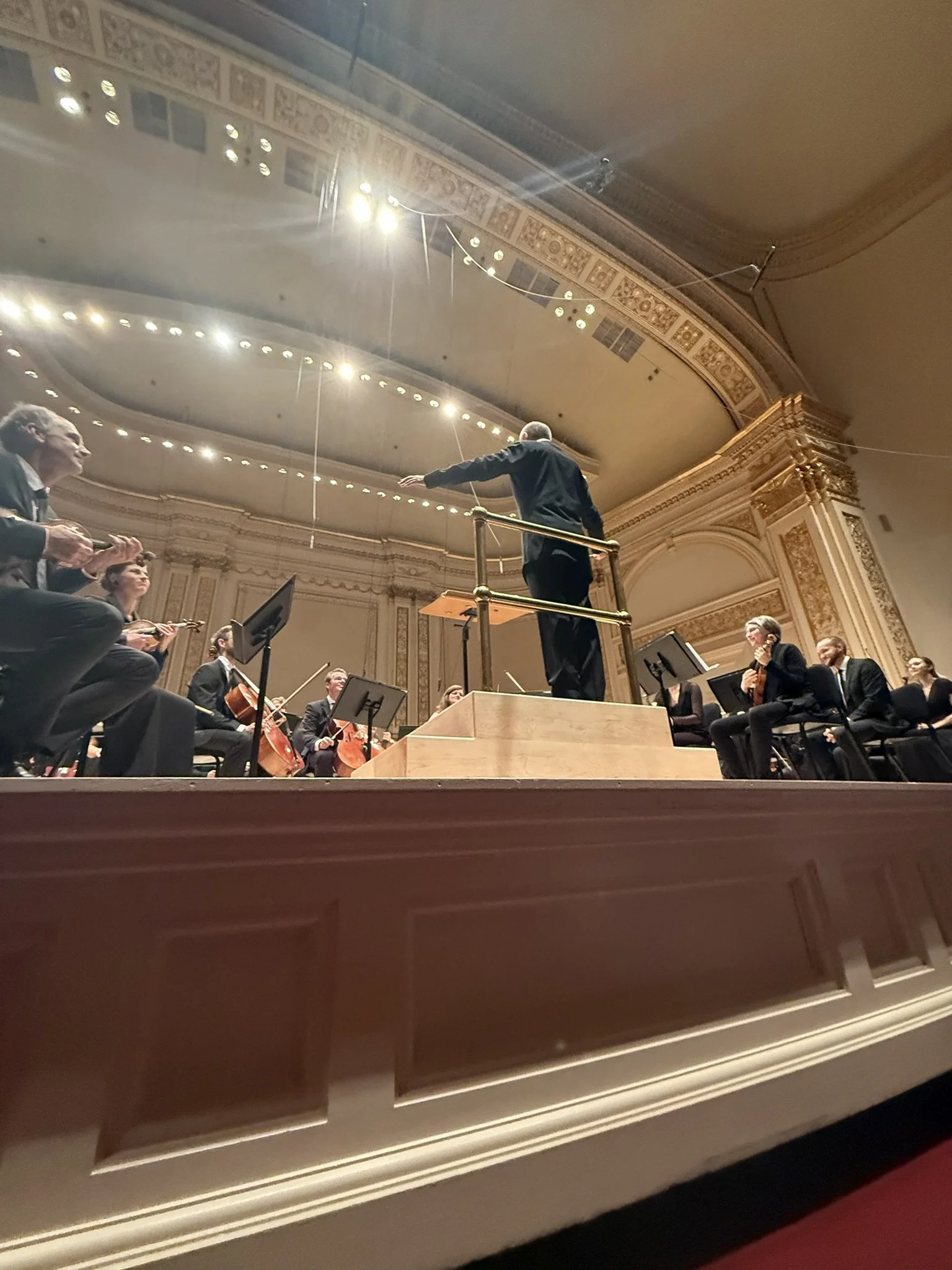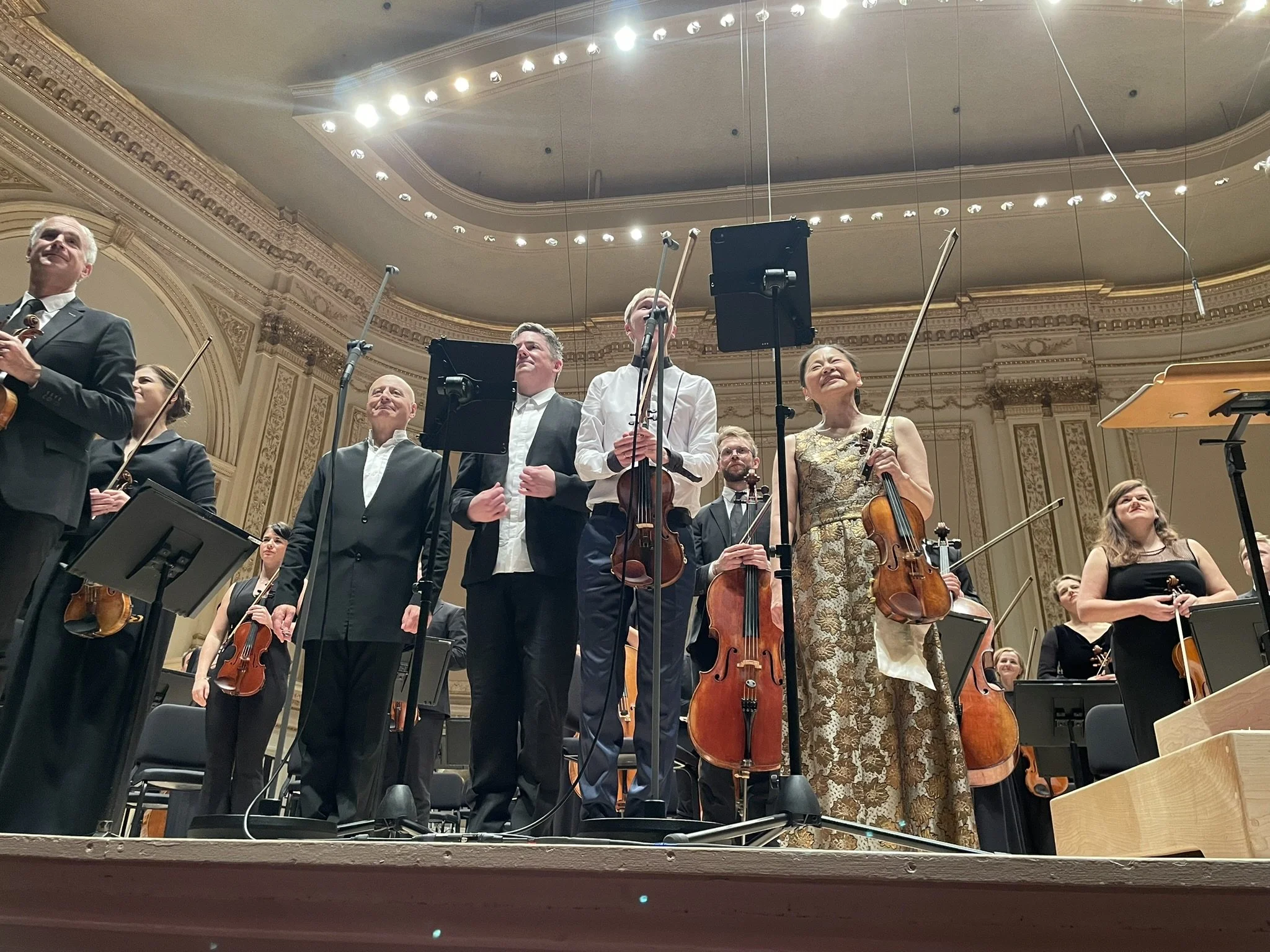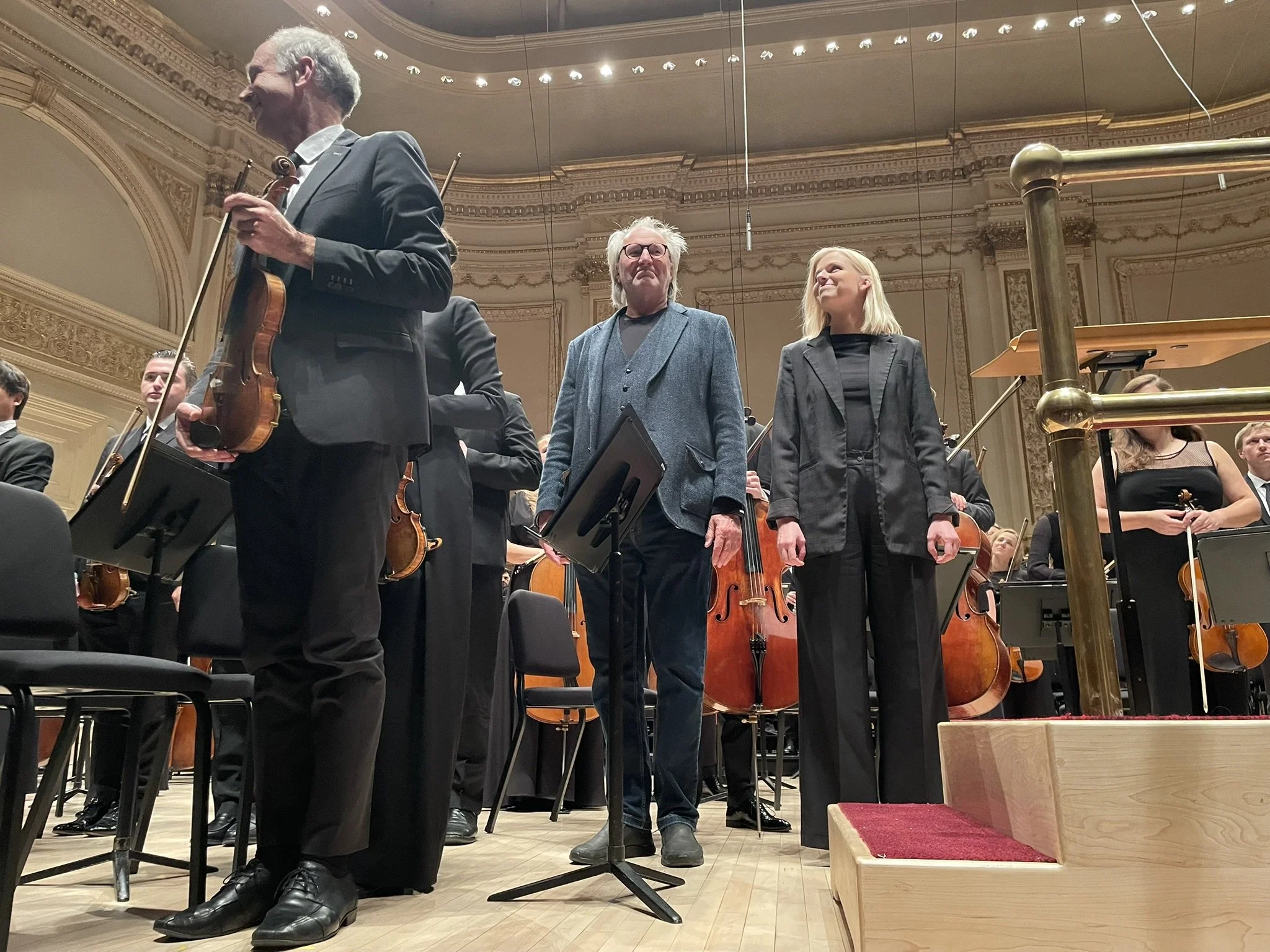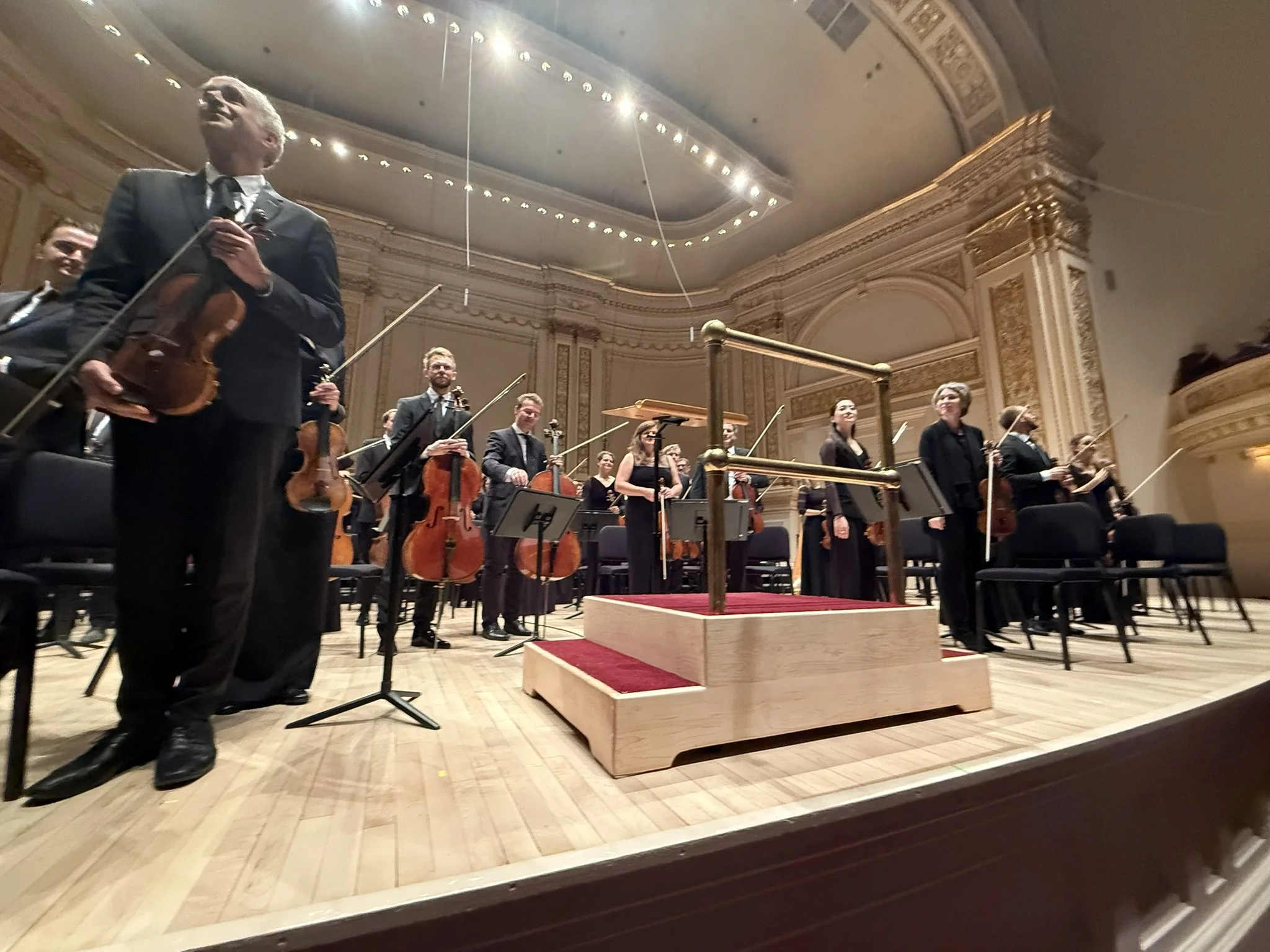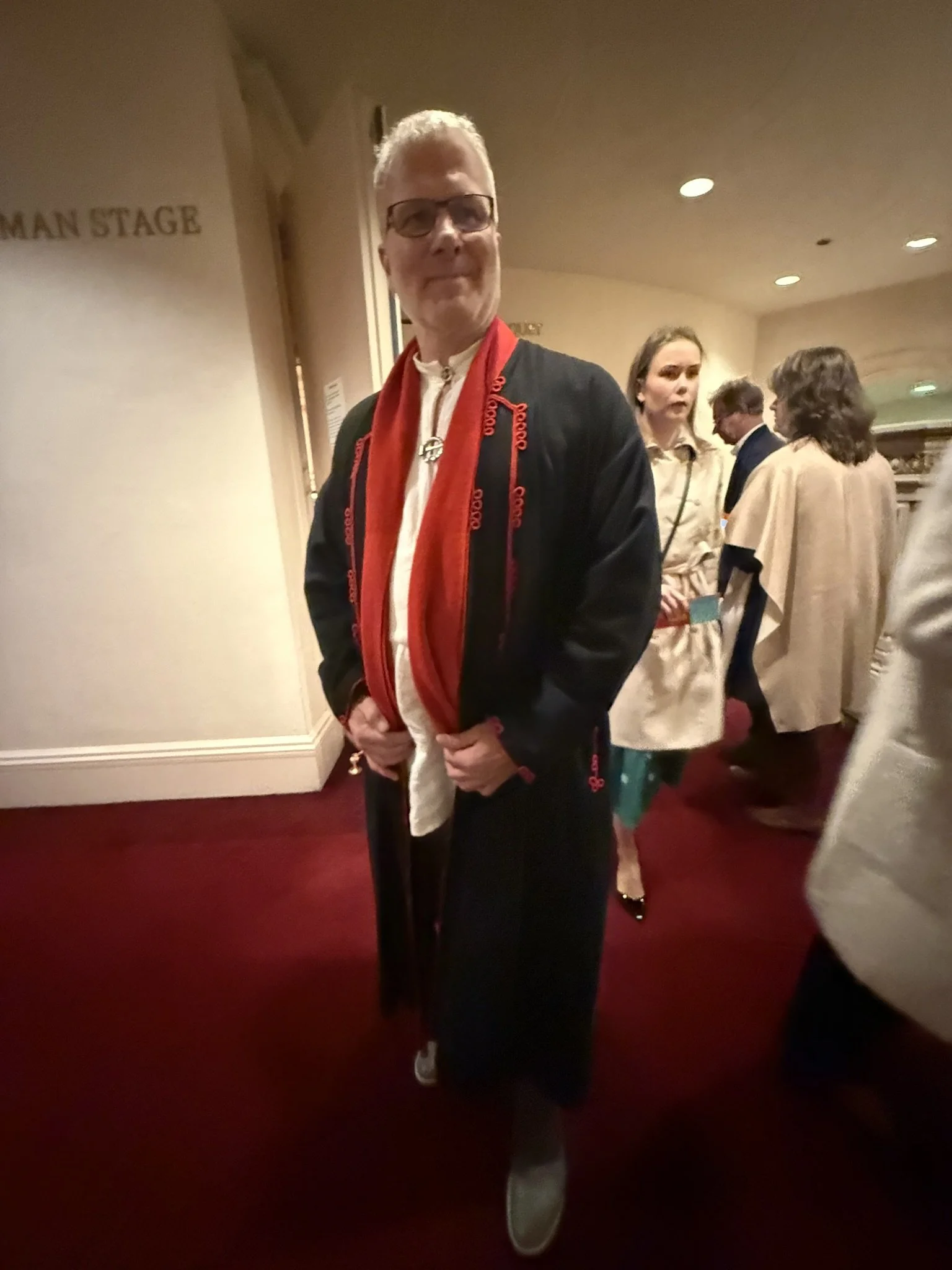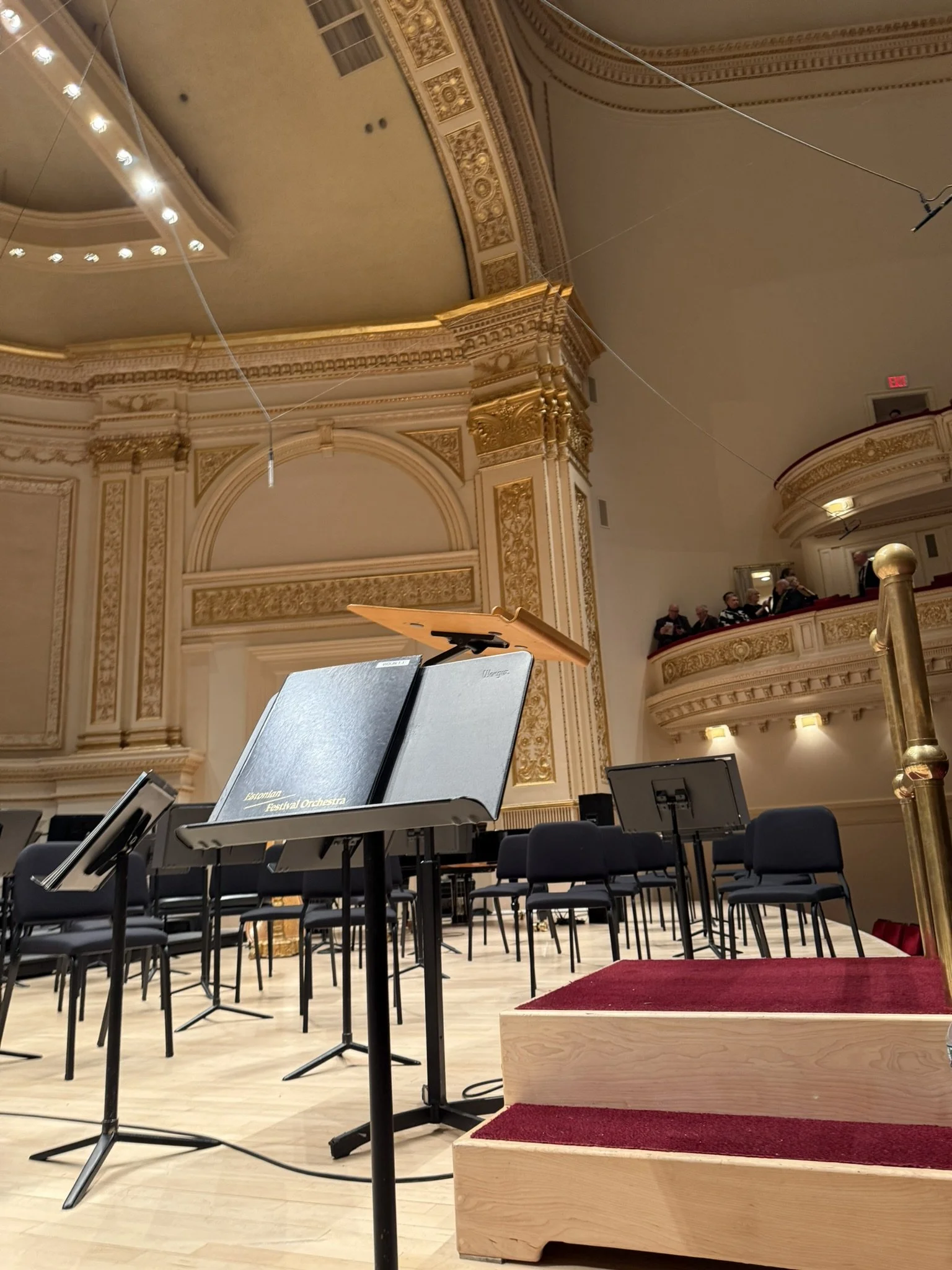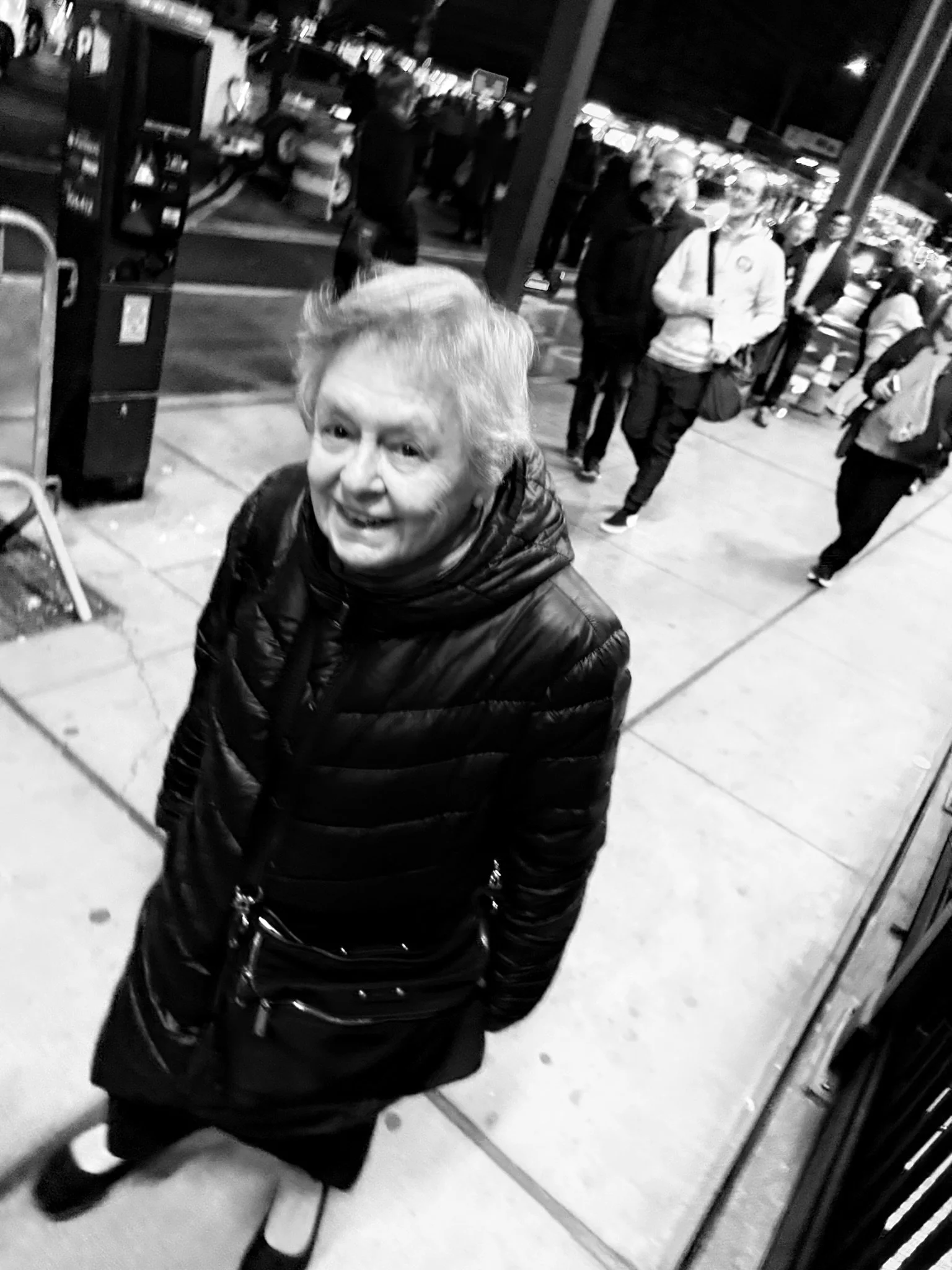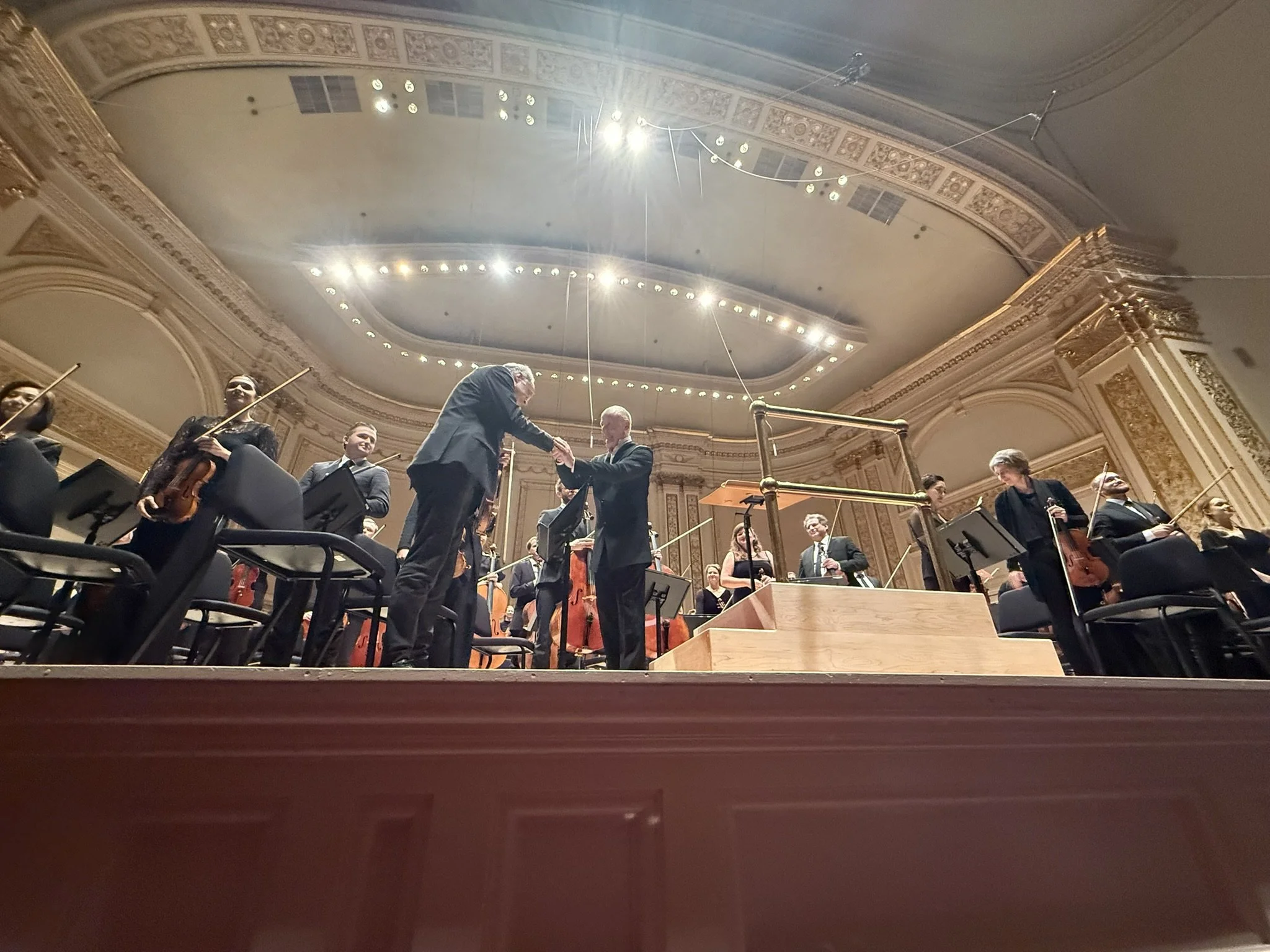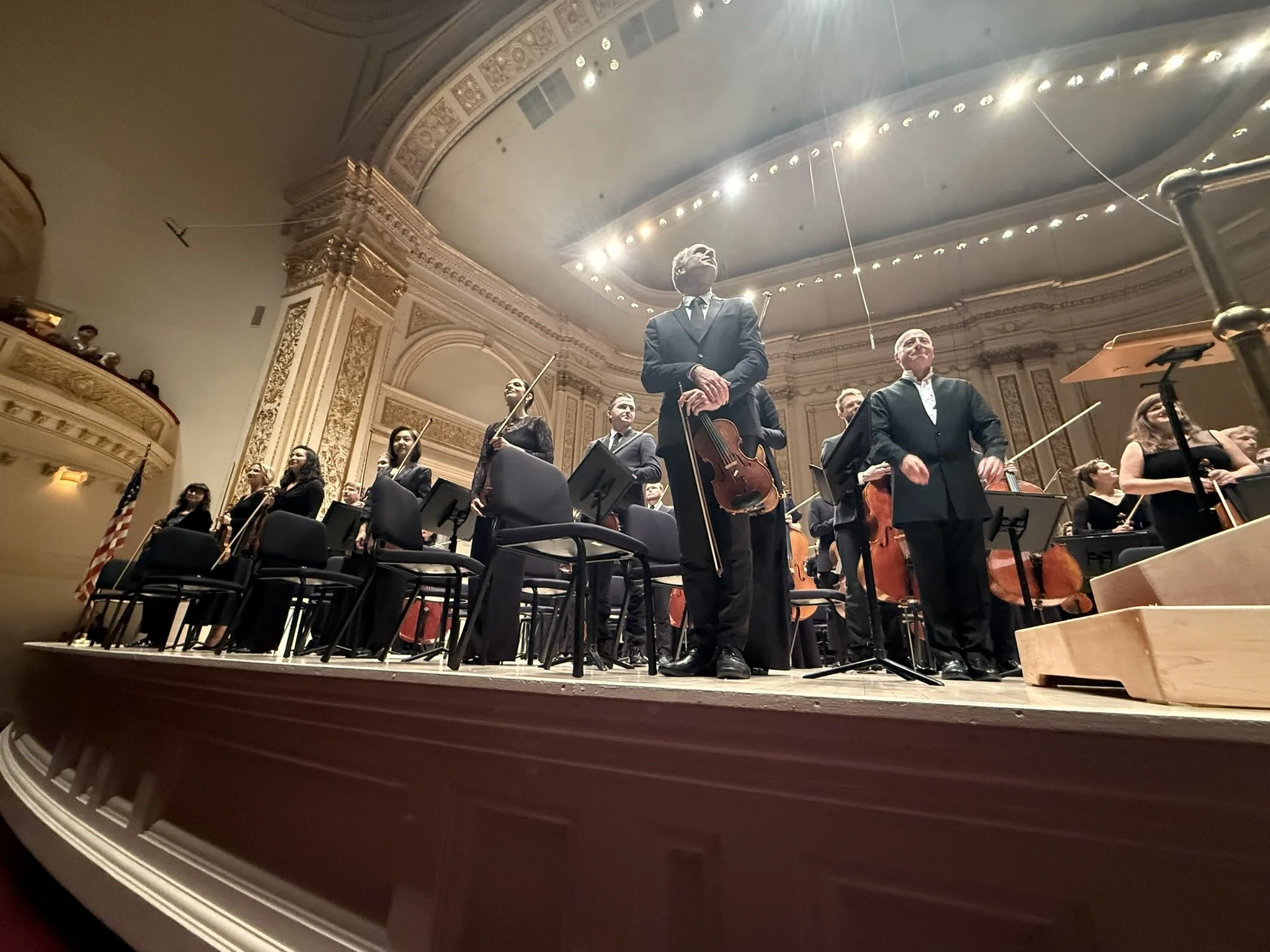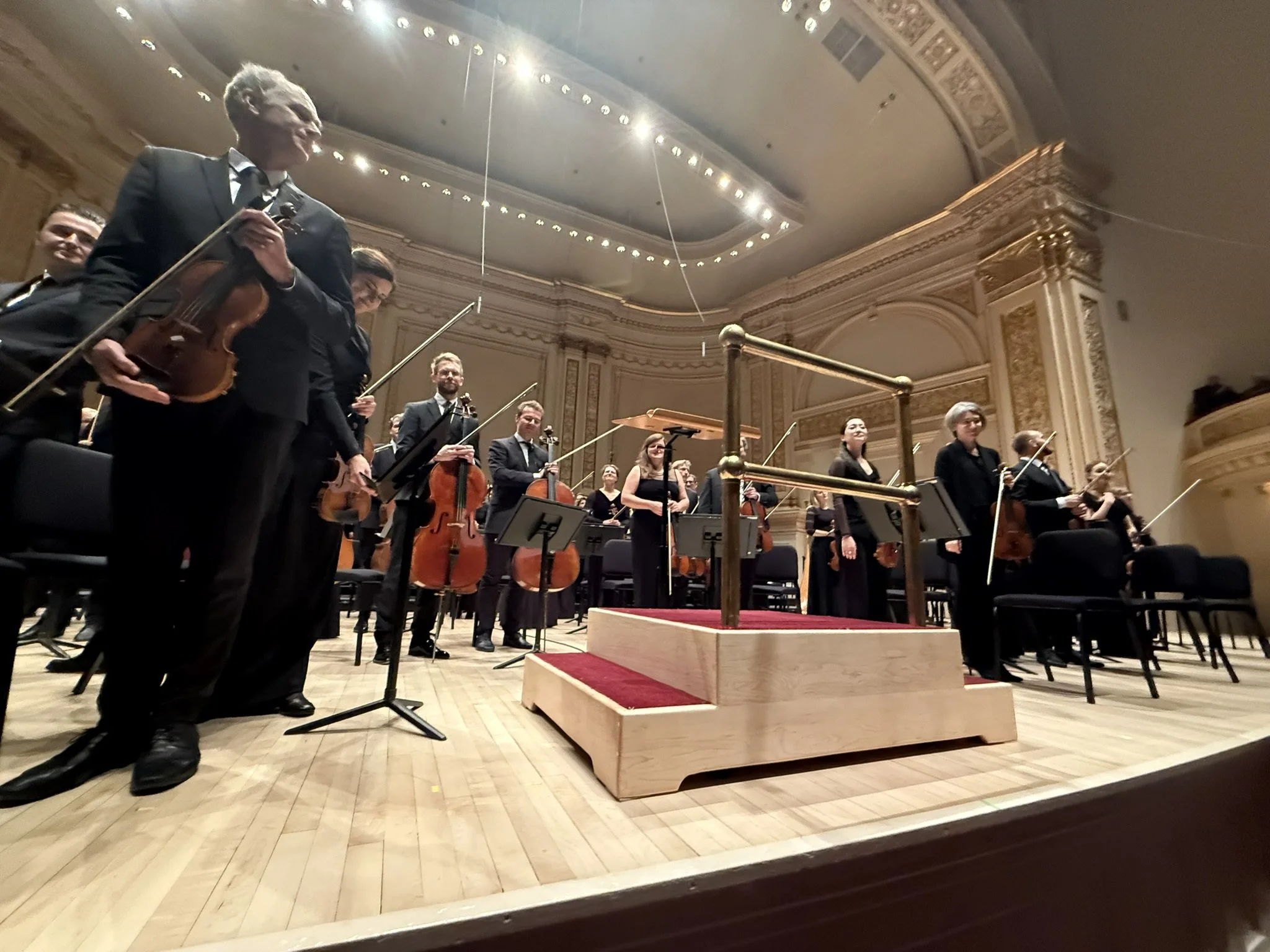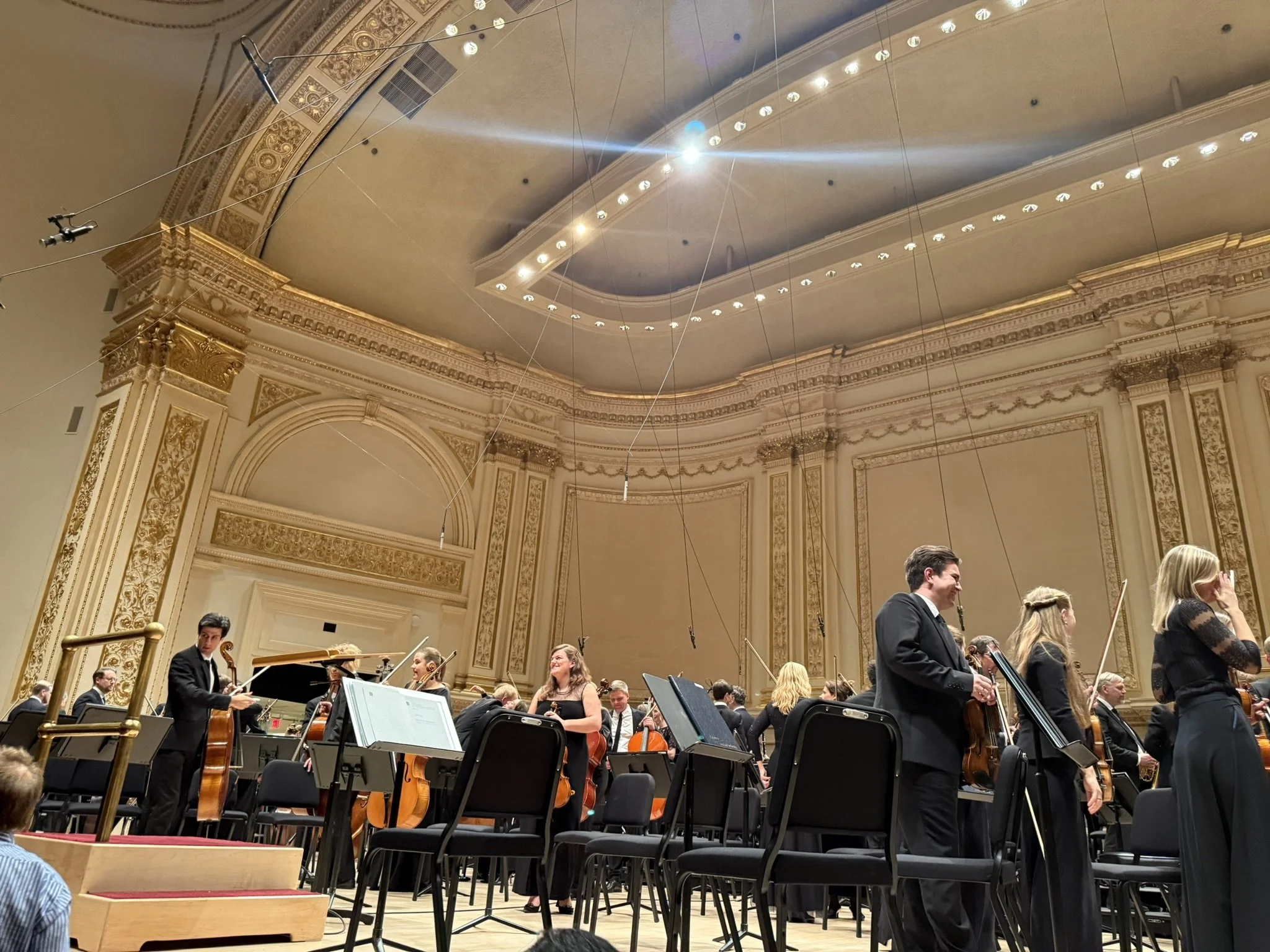Listen to the power of silence from Carnegie Hall from WQXR Carnegie Live
Estonian Festival Orchestra and Choir, conducted by Paavo Järvi, celebrated Arvo Pärt's 90th anniversary at Carnegie Hall on 10.23.2025. It began with the sound of an A bell on Cantus in Memory of Benjamin Britten in 1977. Both sides' violins began to call, and a minor chord from the cello and viola began to descend slowly in the center, and the bass then joined in. Pärt's three DNAs: Tintinnabuli. After a few bars, fragments of the first and second principal violins emerged, their precious lives. I was in the center of the souls, and suddenly, the bells and all the other sounds stopped, and darkness arrived. It was the same eternity in silence with Tchaikovsky in Israel last week.
At the time, Pärt was in Estonia under the Soviet Union, where his creative freedom was limited, but he found a new way to make music through silence. And in Britten's music, I sensed the purity he sought. The very opening is reminiscent of Wagner's Rheingold and Lohengrin. I sensed no presence of musicians on stage. The Carnegie Hall was filled with Pärt. Everything was dedicated to him and Carnegie Hall.
Next, "Perpetuum Mobile," composed in 1963, was the first of Pärt's pieces to be performed in the United States. The destruction sounds Ligeti, Shostakovich, or Bartók, repeated like a bolero for orchestra, was terrifying. And then darkness again.
La Sindone (The Shroud of Turin), 2006. Orchestra and bells. Human loss and redemption, the path to rebirth. Reconciliation with God. I gazed at the membrane of slowly drifting string sound, and with each bell ringing, I felt myself enveloped. Then I heard Beethoven's Funeral March No. 3. The bells and glockenspiels rang together, and darkness descended once more. The darkness grew deeper. The applause's delay clearly shows the audience's growing immersion.
His extensive study of Russian Orthodox, Adam's Lament, in 2009, for orchestra and chorus, depicts Adam (human), expelled from paradise, as his loss and redemption, and his journey to find a path to rebirth—the orchestra and chorus as an eerily clear sound and raw lament. The border between the string instruments, which joined the voices at the same pitch, disappeared. Tintinnabuli increases the sound transparency, assimilating human and instrument with such purity. The human voice and instruments supported each other throughout these dramatic scenes, reminding me of Beethoven's Missa Solemnis.
Pärt was born in Estonia in 1935, lost his creative freedom under the Soviet Union, fled to Austria in 1980, and then, after a stint in Germany, returned to Estonia in 2010 for the first time in 30 years. Before his exile, Pärt had almost no access to music outside. Then he studied medieval and Renaissance music, seeking the origins of Western music. His simplicity stems from a pure exploration and development of the connection between sound and human, stripped of time-worn elements and unaffected by the evolution or degeneration. And Pärt is incredibly popular. The program notes noted that enthusiasts need to change their view, while those who dismiss him are missing something important, and most people are neither. Audiophiles weary of medieval recitation and the 19th century revere Pärt, while those who prefer atonality see him as simplistic and uninterested. Today, we can hear his music as "profound, easy-listening music" in yoga classes and others. But why, then, did Carnegie Hall executives feature him and invite Estonian and Järvi, his closest acquaintances, to share it with us? There's reason to celebrate his 90th birthday worldwide.
Tabula rasa, coined in 1977, refers to the idea of a blank slate at birth. The two movements, Ludus and Silentium, feature two violins alternating between calling out to and supporting each other, sounding like a Bach Ritornello. My eyes closed as the Ludus from Pärt's Double Concerto. Life blazed from the bows of Midori and Hans Christian Aavik. Menomosso comes and goes, and the reincarnation begins again. Midori's beauty transcended pain and suffering. Hans was filled with brilliance. The arpeggios grew more intense and suddenly brightened. My eyes were opened to a deep, heart-wrenching brilliance, like intense pain. Hans was before my eyes. The orchestra didn't crescendo to the final during the two intense arpeggios.
In Silentium, two fiddles slowly echoed over a string loop. The prepared piano and harpsichord chimed in, and souls drifted in a space. The light from the first piece overlapped. It was as if the warmth of the snowy nights I slept in my mother's arms as a child was being embraced by her soul. The tone was passed on to the viola and cello, descending. When the double bass ended midway, that same sensation echoed forever. And then came the longest silence I've ever seen at a concert hall—a sacred moment in Carnegie Hall, filled with audience and the musicians on stage. The applause began slowly, but God did not erase the echoes in my heart. Then, Järvi said, "We could not possibly leave without playing an encore, Passacaglia by Arvo Pärt," and smiles and applause erupted. The Passacaglia was like Brahms' Double Concerto, the powerful creative spirit and breath. It was as if Midori were leading Hans.
Nico Muhly, who played prepared piano, was a contemporary American minimalist. He was between Glass and Reich at BAM, 2 Boys at the Met, and also on the Tallis Scholars' program. He is now assisting with Pärt's Carnegie dedication.
" The Lord was in "the still small voice"
Fratres, also in 1977, has a tranquil, mystical sound, like a Rama. As time cycles, melodies, and the sound of wooden clappers intertwine, and time slowly melts, I was traveling through eternal time. Järvi's body blends into the space, continuing to send vibrations to the orchestra. The low strings continue, and the simple chords and the sound of wood create the harmonium around a fire in the desert. Perhaps this limited environment was where Pärt found his own sound. My heart was at peace midway through the deep, endless journey. The applause was like the ripples after Mitsuko Uchida finishes Schubert, different from the beginning.
The swansong follows like an echo of the journey. Looking back on this, I feel happiness that it was so; the bright pizzicato loop and the gentle bells that light my heart eventually come together powerfully, with hope, knowing that I have a purpose for traveling with my beloved companions. As I started to think, the thought disappeared. As the notes finished, a gentle ripple arose. It was different from the intense silence at the beginning. The New York audience was intense, intriguing, and, for better or worse, very honest.
Pärt is not as familiar to me as Beethoven or Brahms. This time, I listened to each piece. Savoring the silence, each piece remained strong even after the performance ended.
The end of the program, Credo in 1968. Pärt's the 9th. Credo means "I believe"; it starts in the still, small voice, then the next human's strong echo: "I believe." And as the waves of Jesus Christ receded, Bach's Well-Tempered Clavier No. 1 starts so small. I was in junior high school, playing Bach, a time when every day was a discovery. A time loved music so much—a time when I was not afraid of anything. Every morning, I was in the music room at school. The beautiful geometric chords begin, then become confusing to listeners, and the piano starts to show up. The choir begins to cry out, an eye for an eye, a tooth for a tooth, and the wind instruments become chaotic, with people screaming and ravaging. At that moment, as the instruments continued to resist the words "Nonesse resistendum injuriae" (there is no need to resist being hurt), the voice once again emerged from the unmistakable sound of the tiny Bach. Here, in 2025, at Carnegie Hall, I experienced perhaps the most precious sound I have ever heard played by a human in my life, at this tempo. This beauty is the discipline that brings forgiveness to my wounded heart. And, kindly, Pärt shouted the Credo twice, pushing me forward. With this God-given peace, I now forgive those who have wronged me. For now.
Estonia and Järvi came to dedicate Pärt to Carnegie Hall with an extensive set. I found orchestral and choral excitement in each piece. I look forward to future programs. The encore was Estonian Lullaby. I was captivated by the simple, gentle folk songs right up to the very end.
Speaking in a few sounds, we walked together down a long path of silence and light. It was a heart-to-heart exchange, with bells of peace, sadness, and hope ringing out. When Pärt's music transcends boundaries and touches the human spirit, the audience discovers their true selves, and the ripples fill Carnegie Hall.
On the way back, I met Rana. She is 92 years old and originally from the former Soviet Union. Pärt is different from Shostakovich and Prokofiev. She said many times, " Pärt is not professional, she said. I agreed.
Rana, 92, from USSR said Part is not professional.
アルボ・ペルトの90歳を祝う公演がカーネギーで行われ、エストニアのオーケストラと合唱やヤルビがやってきた。1977に初演されたベンジャミン・ブリテンの思い出にから始まった。Aの鐘の音から始まる。両サイドに展開したバイオリンが鈴を響かせ始め、センターにチェロとビオラのマイナーコードがゆっくりと下降し始める。そして、ベースが寄添う。ペルトの3つのDNA、ティンティナブリ。しばらくバーが進んでから、ファーストとセカンド、それぞれの首席の響きの欠片。彼らの尊い命。やがて、私は魂の渦の中心に吸い込まれ、突然、鐘と全ての音と一緒に消え闇が訪れた。そしてそれは、イスラエルのチャイコフスキーで体験した、静寂の中の永遠と同じだった。
当時のペルトは、ソ連体制のエストニアで、創作の自由を奪われ沈黙を経て新たな作曲法を見出した。そして、ブリテンの音楽の中に、彼が探していた純粋さを感じた 。一番初めの出だしは、ワーグナーのラインゴールドや、ローエングリンを思い出させた。ステージの楽員たちの気配を感じなかった。カーネギーの空間はペルトで満たされていた。全てはペルトとカーネギーホールに奉げられていた。
続くパーペチュウム・モビールは1963年に発表された。1967年にペルト作品としてアメリカではじめて初演された。リゲティ、ショスタコーヴィチやバルトークの破壊が管弦楽でボレロの様に繰り返され恐怖を感じた。そしてまた闇。
ラ・シンドーネ(聖骸布)2006年。管弦楽と鈴。人間の喪失と贖罪、再生への道。神との和解。ゆっくり漂う弦の音の膜を眺めていたが、鐘が鳴るたびに、包まれていった。そして、ベートーベンの3番の葬送行進曲が聴こえた。鐘と鉄琴が同時に響き、また闇が訪れた。闇は、どんどん深く暗くなっていく。拍手のタイミングがだんだん遅くなってきて聴衆が引き込まれてきている様子がよく伝わってきた。
4曲目、2009年のアダムの嘆き。管弦楽と合唱。ロシア正教を深く研究してきたペルト。楽園を追い出されたアダム(人間)の喪失と贖罪、そして再生への道を探す旅。管弦楽と合唱の不気味なほど透明な響きとむき出しの嘆き。一番すごかったのは、同じ高さの声に弦楽器が寄添ったり、消えたりする境目が解らなかった。ティナティンブリの共鳴は響きの透度をあげ、人と楽器をその純度で同化させる。そのドラマの数々を人の声と楽器が支え合う様子はベートーベンのミサソレムニスを思い出させた。
ペルトはエストニアに1935年に生まれ、ソ連に自由を奪われ、1980年にオーストリアに亡命し、そしてドイツを経て、2010年に30年ぶりにエストニアに戻った。亡命するまでペルトはソ連外の影響に触れる機会がほぼなかった。その時期、中世・ルネサンスの古楽を研究し西洋音楽の原点を探った。その単純さは、長い時の中で風化した要素をそぎ落とし、音と人の結びつきを、西洋の進化、または退化の影響を受けず、純粋に研究し発展させたところから来ている。そして、ペルトはとてもポピュラーだ。プログラムノートに、ペルトに熱心な人は思考を多様化させる必要があり、見限った人は何か大事なものを見逃している。そして、大抵の人はどちらでもないと書かれていて気になった。ペルトの楽譜は誰でも演奏できる。中世の朗唱や19世紀にうんざりしたオーディオファンはペルトを崇拝し、無調を好む者はペルトを安易な単純性として関心がないのだ。そして、ペルトの精神性とは無縁の現代では、それを深そうなイージーリスニングとして、ヨガ教室をはじめさまざまな場面で耳にすることができる。しかし、なぜ今、カーネギーホールの支配人は彼を特集し、ペルトを最もよく知るエストニアとヤルヴィを招待して私たちにそれを示してくれたのか。彼が90歳を迎えたことを世界的に祝福する理由があるのだ。
後半、1977年のタブラ・ラサは白紙を意味し、人間の心が生まれたときは空白であるという概念を指す。2つの楽章、ルードゥスとシレンティウムからなり、2つのバイオリンが交互に呼びあい支え合あう。バッハのリトルネロを感じた。沈黙を破ったペルトの2重協奏曲のルードゥスが始まると目が閉じた。五嶋みどりとハンス・クリスチャン・アーヴィクの引く弓から命が燃えている。メノモッソが訪れ、それは消え、また繰り返される輪廻の輪。みどりは痛みや苦しみを通り過ぎた美しさ。ハンスは輝きの詰まった響き。アルペジオの波は激しさを増し、音色が急に輝きを増し、厳しい痛みの様な、深く心をえぐるような高い輝きに目が開いた。視線の先にハンスがいた。最後の激しい2人のアルペジオの波に最後オーケストラはクレッシェンドしない。
シレンティウムは、弦楽のループに2つのフィドルはーゆっくりこだまする。2つの音色はもう違いがわからない。プリペアドピアノとチェンバロが時を告げ、幻想空間でただよう魂のゆらぎ。1曲目の命の光が重なる。幼いころ母に抱かれて眠った雪の夜のぬくもりが彼女の魂に抱かれているようだった。やがて音色はビオラとチェロに受け継がれ、下降しコントラバスが途中で終わると、やはりその感覚は永遠にこだまする。そして、私の演奏会史上で最も長い沈黙が訪れる。2800人の聴衆とステージの音楽家たちで埋まるカーネギーには、神聖な時間が宿った。ゆっくりと拍手が始まったが、神は私の心に響く余韻を消すことはなかった。しかし、ヤルヴィが「アンコールをせずに帰るわけにはいかない。We could not possibly leave without playing an encore. Passacaglia by Arvo Pärt」と言うと、客席から笑顔と拍手が湧いた。パッサカリアはブラームスの二重協奏曲のようだった。生きた人間の力強い創造の精神と息遣いを感じた。まるでみどりがハンスをリードしているようにも見えた。助かった。この曲では、プリペアードピアノをニコ・ミューリーが演奏した。彼は現代アメリカのミニマリストを代表する作曲家だ。グラスとライヒの間でライヒの曲を一緒に演奏する姿を目にした。メットで2ボーイズを3度見た。タリス・スコラーズが彼の曲を取り上げたときも聴いた。彼は今回、ペルトのカーネギー奉納祭を手伝っている。
*プログラムから聖書の節を引用。
One recalls the scriptural passage where “the Lord was not in the wind … the Lord was not in the earthquake … the Lord was not in the fire.” The Lord was in “the still small voice” (I Kings 19:11–12).
「主は風の中におられなかった…地震の中にもおられなかった…火の中にもおられなかった」という言葉が思い浮かびます。主は「静かな細い声の中におられた」
続くフラトレスも1977年に発表された。ラマのように静謐で神秘的な響き。永遠の時の巡りの中、旋律と拍子木の音が交錯し、時間はゆっくりと溶けていく。私は、永遠の時を旅する者たちの一人となった。ヤルヴィの肉体は空間に溶け込み、永遠の時を流れる波動を送り続ける。低弦の微かな響きが続き、シンプルなコードと木の音が、まるで砂漠で火を囲み、ハルモニウムを聴いている錯覚をもたらす。きっとペルトは、限られた環境の中でそうして自分の響きを見つけていったのかもしれない。小さなハルモニウムが、永遠の時を静かに刻む心深く終わりない旅の途中で心が落ち着いた。聴衆の拍手は内田光子がシューベルトを弾き終えた後のさざ波のようだ。はじめと全然違う。
続く白鳥の歌は神秘の旅の余韻のようだ。長く続く旅を振り返った時に、本当にそれでよかったと思える、明るいピッチカートのループ、心に光をともす鐘のやさしい響きが、やがて力強く一つになっていく。私には愛する仲間と旅をする目的があると希望が溢れてくる。そう思えてくると、やがて静かにその思いは閉じた。最後の音色が終わると、やさしいさざ波が起こる。はじめの強い静寂とは全然違う。ニューヨークの聴衆は強くて興味深くて、そして良くも悪くも素直だ。
私にペルトはベートーベンやブラームスほどなじみがない。今回は一曲一曲、ただ聴く。静寂をかみしめるので、演奏が終わっても、その曲の光がそれぞれ強く残っていった。
最後だ。クレド。1968年。ペルトの第9。クレド、私は信じるとそっと始まる。次の瞬間、爆発。そして、イエスキリストと静かに波が引いていくと、たった一台の小さなピアノでバッハの平均律の1番を奏で始める。毎日が発見だったバッハを弾いていた頃、中学生だった。音楽が好きでたまらなかった時だ。何も怖くなかった時だ。やがて、メシアンの様な美しい幾何学のコードは混乱し始め、ピアノが自分を主張し始める。合唱が、目には目を、歯には歯をと叫び始めると、管楽器が混乱した動物園のような大騒ぎになり、人間が悲鳴をあげ大混乱になる。その時、Non esse resistendum injuriae 傷つけられることに抵抗する必要はないという言葉に、楽器の抵抗が続く中、その透明な響きの中から、再び小さなバッハから神の声が導かれる。カーネギーで2025年の今、このテンポで、生涯聴いた人が奏でる音で多分一番尊い音を体験した。この美しさは鍛錬の結晶だ。その結晶は傷だらけの心に許しのやすらぎを与えてくれた。そして、ペルトは本当に親切なことに、一歩が踏み出せるように、2度、とても強く、クレドを叫ぶ。背中を押されている。この神が与えてくれた安らぎに、今は、いままでひどい目にあわされてきた人々を許します。今は。
今回のこの大規模なセットを通して、エストニアとヤルヴィはペルトをカーネギーに奉げに来たわけだが、やはり、それぞれの作品から、管弦楽と合唱の胸が躍るようなうまさを見つけてしまった。将来のプログラムが楽しみだ。アンコールはエストニアの子守歌。素朴でやさしい民謡に最後まで心が奪われた。
少ない音で語り、静寂と光の長い道を共に歩む。平和と悲しみ、そして希望の鈴が響く心の交流。ペルト音楽が境を越え人間の精神に触れた時、聴衆は本当の自分に出会い、それはさざ波となってカーネギーを満たすのだ。
帰りに、ラナに出会った。ラナは92歳で、旧ソ連出身。ペルトはショスタコービチやプロコフィエフと違う。ペルトはプロフェッショナルじゃないと何度も行ってきた。私もそう思う。

